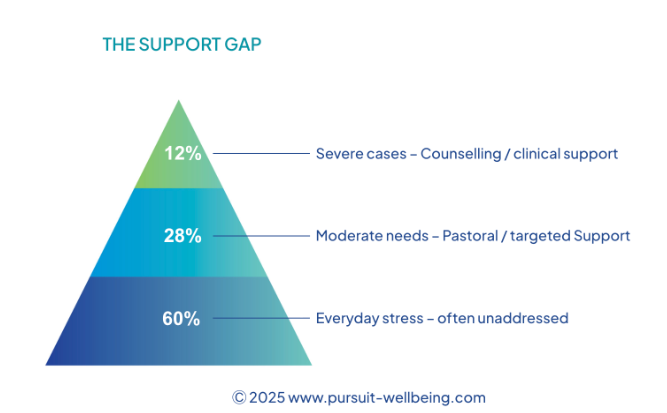A practical guide for school leaders on building a sustainable wellbeing strategy ~ fully aligned with the new EIF emphasis on wellbeing and inclusion ~ by managing energy, focus and culture, the essential foundations for headteacher wellbeing and effective leadership.
Imagine I could magically give you one extra hour today. What would you do with it?
Would you use it to catch up on emails, think strategically, or finally take a quiet moment to yourself?
Really think about it – what would make that hour genuinely restorative or productive for you?
Now imagine you’re exhausted. Would that hour be as useful?
Or if you’re furious after a difficult conversation, emotionally drained and distracted – would that hour help you get more done?
That’s the heart of strategic wellbeing. It’s not just about managing your diary – it’s about managing your energy and focus. Without those, even more time won’t make a difference.
Headteacher wellbeing isn’t a luxury. It’s the foundation of effective school leadership, allowing you to think clearly, lead with confidence, and sustain your capacity through the realities of school leadership today.
1. Energy: The Foundation of Strategic Wellbeing
A sustainable wellbeing strategy begins with energy. As a school, college or MAT leader, your energy is your most precious leadership resource. It’s worth protecting – especially because most leaders instinctively protect everyone else’s energy and wellbeing long before they even think about their own. After working with almost a thousand school and college leaders, I can say with certainty: this pattern is almost universal.
Many leaders describe days that start at full tilt and never seem to stop. Safeguarding issues, staffing challenges, and curriculum pressures all compete for attention, leaving little time for reflection or recovery. Over time, that relentless pace can erode resilience, clarity and, eventually, your capacity to lead well.
Start by noticing your energy patterns.
- When during the day do you feel most focused or creative?
- Which meetings or tasks leave you depleted?
- Where do you get genuine renewal? A classroom visit, a walk with a colleague, time spent mentoring others?
These insights help you design your week around energy, not just tasks.
That might mean planning difficult conversations when you know you’ll be clear-headed, structuring the day to include brief resets between meetings, or ring-fencing a short slot to think rather than react.
This isn’t indulgence. It’s strategy.
Energy management is a leadership skill. When you protect your energy, you make better decisions, communicate with empathy, and model resilience for your staff.
A sustainable wellbeing strategy starts by recognising that energy is your most valuable leadership currency.
2. Focus: Creating Space for Deep Work
So many headteachers tell me they struggle to find time for deep work. An open-door policy supports staff connection, but it often leaves you with fragmented attention and a sense of constantly firefighting.
Effective school leadership wellbeing depends on focus. Without protected time, everything becomes reactive.
Make focus an intentional part of your leadership wellbeing strategy:
- Protect one uninterrupted hour a day for deep work – writing a governors’ report, shaping priorities, thinking or reflecting.
- Create weekly or fortnightly strategic time, ideally a half or full day outside of school every two or three weeks, to work on, not in, your leadership. I know this isn’t easy ~ in some settings it feels almost impossible ~ but it’s worth aiming for to the degree you can.
- Define your strategic priorities each half-term, each week, and each day. When you’re clear on what matters most, it’s easier to say no to what doesn’t. These plans can easily be derailed, but having them gives you something solid to return to when the day runs away from you.
Remember: saying yes to everything dilutes your impact.
Saying yes to what truly matters strengthens it.
When your focus is clear, your energy follows. And when you model focus, your team learns that boundaries around attention aren’t indulgent – they’re vital.
3. Culture: Leading by Example
Headteacher wellbeing is never just an individual pursuit. It’s the anchor for the wellbeing culture of your school.
Your actions shape the unspoken norms – what’s encouraged, what’s expected, and what’s quietly admired. When you demonstrate balance, maintain boundaries, and recognise others’ efforts, you give permission for your team to do the same.
A healthy school wellbeing culture grows from modelling:
- Leaving meetings on time.
- Taking a proper lunch break (at least occasionally).
- Acknowledging staff achievements publicly.
- Being open about your own need for reflection or recharge time.
These actions aren’t symbolic – they create ripple effects. Staff feel safer to rest, to speak up, and to protect their own boundaries. Over time, this fosters whole-school wellbeing, psychological safety and stronger morale and performance.
Leaders often ask, “But how do I influence culture when the system itself is so pressured?”
You begin with what you can control: your energy, your focus, and the example you set. That influence spreads, through your senior team, to staff, and ultimately to your pupils.
4. Reflection and Growth
Sustainable wellbeing isn’t about doing less. It’s about doing what matters most, with clarity and intention.
It means recognising that rest and reflection are not the opposite of productivity; they’re prerequisites for it.
It means viewing your leadership capacity as something to be sustained, not spent.
And it means aligning your energy, focus, and purpose so that you can sustain both yourself and your school.
Ask yourself:
What one small change could I make this week to protect my energy, sharpen my focus and strengthen my wellbeing as a headteacher?
Even a small shift ~ one clearer boundary, one hour of protected time, one honest conversation ~ can be the start of a more sustainable approach to leadership.
You don’t have to manage the pressures of headship alone.
For practical tools and support to protect your wellbeing and lead with clarity, visit: https://pursuitwellbeing.com/support-for-headteachers-under-pressure/




